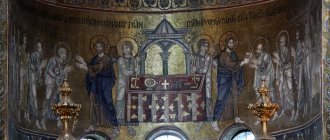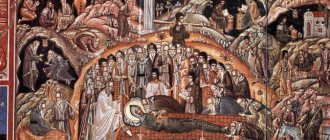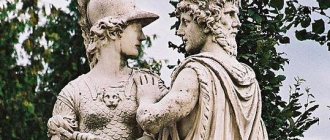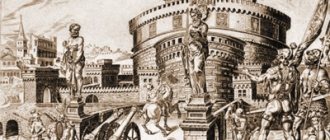GREGORY XIII
Gregory XIII, Pope of Rome. Engraving. 1600 (Saachi. Vitis pontificum. 1626) (RSL)
Gregory XIII, Pope of Rome. Engraving. 1600 (Saachi. Vitis pontificum. 1626) (RSL) (01/1/1502, Bologna - 04/10/1585, Rome; before being elected pope - Ugo Boncompagni), Pope (from May 13, 1572). Genus. in a wealthy merchant family, he studied at the University of Bologna, where in 1530 he received the degree of Doctor of Canon and Civil Law (in utroque jure). In 1531-1539 taught at the university. In 1538, Pope Paul III recruited Ugo Boncompagni as a lawyer to work in the Roman Curia. In 1546, as abbreviator Boncompagni, he participated in the work of the Council of Trent (also in 1561-1563). Under Pope Paul IV in Jan. 1556 became a member of the papal commission working on preparing reforms in the Catholic Church. Churches. In the position of papal datarius he was assistant to the card. Carlo Caraffa, nephew of Paul IV, accompanied the cardinal to France, where he was sent as papal legate, and to the Spanish court. cor. Philip II in Brussels. In 1558, Boncompagni was ordained a presbyter, and on July 20 of the same year he was named bishop of Vieste. Pope Pius IV appointed Boncompagni prefect of the supreme papal tribunal Signatura apostolica, and on March 12, 1565 he elevated him to cardinal presbyter of Rome. c. Sixta (received May 15, 1565). In the fall of 1565 he was sent as legate to Spain to investigate the case of the archbishop. Toledo Bartolome Carranza. After the death of Pius IV, Boncompagni, who was not present at the conclave, was considered as one of the possible contenders for the Papal throne, but in January. 1566 Bishop was elected pope. Nepi Antonio (Michele) Ghislieri (see Pius V), under whom Boncompagni became a member of the Roman commission created by the new pope. proofreaders (Correctores Romani) for streamlining the codes of canon law and preparing official documents. publications "Corpus juris canonici".
After the death of Pius V card. Ugo Boncompagni with support from card. Antoine Granvely, then vice-cor. Neapolitan and close Spanish. cor. Philip II, was elected pope and ascended the Roman throne. A supporter and conductor of the Counter-Reformation, G. prepared a number of reforms in the spirit of the Council of Trent. In contrast to the strict asceticism of Pope Pius V, G.'s reign, probably due to his legal education, according to contemporaries, was characterized as more secular.
Declaring himself as an opponent of nepotism, G. nevertheless appointed his nephews as cardinals - Philip Boncompagni (from June 2, 1572) and Philip Vastallano (from July 5, 1574); the 3rd nephew was denied the rank. Brother G., who asked the pope for financial assistance, was denied access to Rome. G. was the last pope, about whom it is known for sure that he had illegitimate children - the son of Giacomo. before Ugo Boncompagni was ordained as a priest. G. arranged the marriage of his son with the Countess of Sforza and elevated him to the position of manager of the castle of St. Angel and gonfaloniere of the Roman Church (commander-in-chief of the troops of the Papal States).
Already on the day of his election, G. informed the ambassadors of Spain and Portugal that he intended to continue the fight against the Turks, begun by his predecessors, and to provide assistance to the Holy Antitour. league, organized by Pope Pius V. However, the conflict between the members of the league, primarily Spain and Venice, which entered into separate peace treaties with the Ottoman Empire (Venice in 1573, Spain in 1581), prevented the achievement of the kl. successes in the fight against the Ottoman threat. The main direction of Georgia's policy was the fight against the spread of Protestantism. Papal legates acted at the courts of France, Spain, Portugal, and there. principalities, in Sweden and in Poland, trying to contain the Reformation at any cost. It is traditionally believed that the pope reacted positively to the news of St. Bartholomew's Night (Aug. 24, 1572), which he called “a very joyful event for the entire Christian world” (Romier L. La S.-Barthélemy // Revue du XVIe siècle. 1913. P 530), the victory of the Church over the heretics. However, in modern research clarifies that the pope not only did not take any part in the preparation of the massacre, but, moreover, as a lawyer, he regretted that the French. cor. Charles IX failed to resort to more legal methods of punishing heretics. Later, in order to support the fight against the Huguenots in France, G. blessed the Catholics who fought against the “new heresy” (February 15, 1585). Secret agreements were concluded with Spain. by the Inquisition. By the bull “Antiqua Judeorum” (1581), G. extended the powers of the Inquisition to cases related to Jews and Muslims. According to the bull “Consueverunt Romani pontifices” (1583), the categories of those excommunicated from the Church were expanded - among them were not only heretics, but also pirates, bandits demanding ransom, counterfeiters and other disturbers of public peace.
The pope had great hopes for an alliance with the Spanish. king against english cor. Elizabeth I. In the Netherlands, he also supported the fight against Prince William of Orange and the Gueuze, hoping to use these lands as a springboard for the fight against Protestants. England. In Sweden, where in 1577 the Jesuit Antonio Possevino, cor. John III Vasa under the influence of his Catholic wife Catherine Jagiellonka, sister of the Polish. cor. Sigismund II Augustus, agreed to retain Catholicism in his state. faith, provided that the celebration of Mass in the national language, communion with bread and wine, marriage of clergy, refusal to venerate saints, and also that the former. church property that passed to secular owners during the years of the Reformation will be retained by them. After G.’s refusal to recognize such a “reconciliation of religions” as possible, after the death of Catherine the Jagiellonian (1583) and a new marriage with a Lutheran Swede. the king finally fell away from Catholicism, becoming a Lutheran. faith. In Poland, the pope approved the election of Stefan Batory as king (1576), who subsequently supported the Catholic clergy and Jesuits in the fight against the reform movement.
Coat of arms of Gregory XIII. Unknown artist. Painting of the Redemptoris Mater Chapel. XVI century
Coat of arms of Gregory XIII. Unknown artist. Painting of the Redemptoris Mater Chapel. XVI century
In an effort to implement the decisions of the Council of Trent, the pope first of all took measures to ensure that the documents of the Council were made public everywhere. Following the conciliar decisions, he made mandatory visits of church provinces to the North from 1573. and Center. Italy. In other regions (for example, in the Catholic cantons of Switzerland, in N. Austria and Tyrol), papal nuncios became the conductors of papal policy. In St. The Roman Empire was in the midst of the active spread of Protestantism, which threatened to fall away from the Catholic Church. Churches of the Archbishop of Cologne (in 1582, Archbishop of Cologne Gebhard II von Waldburg declared himself a Calvinist, his joining the Protestant electors gave them an advantage in the college that elected the emperor), the pope had to agree to the election in 1583 of the Catholic Ernst of Bavaria to the archbishopric see , brother Hertz. Bavarian Wilhelm V, despite the fact that the Archbishop of Cologne by that time was simultaneously the Bishop of Münster, Liege, Freisingen and Hildesheim.
To strengthen church discipline (this demand was also put forward at the Council of Trent), G. carried out a number of transformations of the Roman Curia. In an effort to control the process of appointing bishops, the pope demanded the compilation of a list of those priests who in the near future, if there were vacancies, could receive the episcopal rank, so that the most complete information about the candidates would be collected and only worthy ones would be appointed to vacant positions. The Congregation for Bishops was organized (in 1601, together with the Congregation for Religious Affairs, it became part of the Congregation for Bishops and Religious Affairs) and the Congregation for Ceremonial Affairs (1572). The financial structure of the Catholic Church was changed. Churches, control over income was transferred to the Apostolic Chamber (Camera apostolica). G. laid the foundation of Bud. Congregation for the Propagation of the Faith (Propaganda fidei) - a committee of 3 cardinals was entrusted with the leadership of the Catholic Church. missions in the East to support Eastern Catholics. ritual in canonical communication with the Roman throne and the spread of Catholicism. faith among the Orthodox population. For the same purpose, G. contributed to the publication of the Catholic Catechism. Churches to the east languages. Catholic missionary activity. monastic orders for non-European territories received support from G. The Jesuits began active missionary work in China and Japan, receiving papal privilege and being the only order that could carry out preaching activities in these lands, as well as in Peru, Mexico, and the East. Africa and the Middle East. The Pope provided significant financial assistance to the Jesuit college in Japan. The missions of the Augustinians and Franciscans worked in the Philippine Islands, and in 1579 the Bishop of Manila was founded there.
In con. 1577 - beginning In 1578, the Jacobite Antiochian Patriarch Ignatius Namatalla was in Rome, with whom negotiations began on concluding a church union of the Roman Catholic Church and the ancient Eastern Churches (Syrian (Jacobite), Coptic and Ethiopian). The unions were concluded after G.'s death (see Art. Eastern Catholic Churches).
In 1581 Russian. Tsar Ivan IV Vasilyevich the Terrible turned to G. with a request for mediation in concluding peace between the Russian state and the Grand Duchy of Lithuania. Possevino was sent to Moscow, also authorized to negotiate a union. After the signing of the Peace of Yam-Zapolsky, Possevino arrived in Moscow, where, with the permission of Ivan the Terrible, he held (February 21, 23 and March 4) public debates about faith, after one of which, in a fit of rage, the tsar almost killed the papal legate. Possevino's mission was completed without bringing any results in the union negotiations.
Following the Council's program for the revival of Catholicism. spirituality, the pope supported the activities of the Jesuits, Capuchins and other orders. In 1575, with the bull “Copiosus”, G. approved the Oratorian Order, and in 1579 he reorganized the Western Order. branches of the Basilian Order (bull “Benedictus Dominus”). In 1580, the pope approved the reform of the Carmelite Order carried out by Teresa of Avila, as a result of which a branch of Discalced Carmelites and Carmelites emerged.
G. instructed C. Baronius to edit and prepare for publication the Roman Martyrology. In 1582 the official was published. collection of Catholic laws approved by G. (bulla “Cum pro munere pastorali”). Church "Corpus juris canonici", valid until 1917. In the process of preparing the 4-volume edition, ancient manuscripts of Gratian's Decree and codes of decretal law were searched and compared in order to eliminate errors and discrepancies.
In 1582, the pope carried out a calendar reform. Its necessity was already announced at the Council of Trent: due to the error of the Julian calendar, the date of March 21, traditionally considered the early boundary of the Paschal full moon, gradually retreated from the astronomical spring equinox and by 1545, when the Council opened, was 10 days behind it. A special commission was organized to prepare the reform; the final draft (compiled by astronomer L. Lilio) received the approval of many. European univ. It was proposed to remove the 10 days accumulated by following the Julian calendar since the Council of Nicea (325), and to avoid their accumulation in the future, skip 3 leap periods every 400 years; for this purpose, years divisible by 100, but not divisible by 400, were taken as ordinary years instead of leap years (1700, 1800, 1900, 2100 and 2200 are ordinary years; 1600, 2000 and 2400 are leap years). Thus, the border of the Easter year, March 21, again, as in the 4th century, returned to the point of the vernal equinox. At the same time, the method of determining full moons was also subject to correction (see articles Calendar, Easter). The new calendar, which received the name “Gregorian” after G., was put into effect by a bull of February 24. 1582 "Inter gravissimas". After 4 Oct. that year, all Christians were ordered to count October 15 at once. In 1583, the pope sent an embassy to the Polish Patriarch Jeremiah II with gifts and an offer to switch to a new calendar. In con. In 1583, at the Council in K-pol, this proposal was rejected as not corresponding to the canonical rules for the celebration of Easter.
G., more than any of his predecessors, tried to turn Rome into a Catholic center. church education - under the Roman College (see article Gregorian University), the German College (bulla “Postquam Deo placuit”, 1574), the Greek College of St. Athanasius (bul "In apostolicae Sedis", 1577), College of the Angles of St. Thomas (bull “Quoniam divinae”, 1579) and the Maronite College (bull “Humana sic ferunt”, 1584), the purpose of which was to train priests of the East. rite. The Roman College received a new building and an annual cash grant. In 1575, the anniversary year (“annus sanctus”) was widely celebrated in Rome; approx. 400 thousand pilgrims. For this event in Rome, work was carried out to reconstruct roads, fountains were broken, including 2 on the square. Navona, construction of the Quirinale Palace began.
G. died in Rome and was buried in the Basilica of St. Petra.
Source: Magnum bullarium romanum / Ed. L. Cherubini et. al. Luxemburgi, 1742. Vol. 2. P. 387-526; Levi della Vida G. Documenti intorno alle relazioni delle Chiese otientali con la S. Sede durante il pontificato di Gregorio XIII. Vat., 1948.
Lit.: Karttunen L. Grégoire XIII comme politicien et souverain. Helsinki, 1911; Schelnass K. Wissenschaftiche Forschungen unter Gregor XIII. für die Neuausgabe des Gratianischen Dekrets // Papsttum und Kaisertum: Forschungen z. politischen Geschichte und Geisteskultur des Mittelalters: FS P. Kehr / Hrsg. A. Brackmann. Münch., 1926. S. 674-690; Pastor L. Grégoire XIII: Trad. de l'allemand. P., 1938. 2 vol. (Histoire des Papes depuis la fin du Moyen Âge; 19-20); Pecchiai P. La nascità di Giacomo Boncompagni // Archivi: Archivi d'Italia e rassegna internazionale degli archivi. R., 1954. Ser. 2. Vol. 21. P. 9-47; Catalano G. Controversie giurisdizionali tra Chiesa e Stato nell'età di Gregorio XIII et di Filippo II. Palermo, 1955. (Atti dell'Accademia di Scenze, Lettere ed Arti di Palermo. Ser. 4. Vol. 15. Pt. 2. Fasc. 1); Lukács L. Die nordlichen päpstlichen Seminarien und P. Possevino (1577-1587) // Archivium Historicum Societatis Iesu. 1955. Vol. 24. P. 33-94; Pauline St. Une tentative d'Union au XVIe siècle: La mission religieuse du Père Antoine Possevin, SJ en Moscovie (1581-1582). R., 1957. (OCA; 150); Prodi PS Carlo Borromeo et la trattative tra Gregorio XIII et Filippo II sulla giurisdizione ecclesiastica // Rivista di storia d. Chiesa in Italy. R., 1957. Vol. 11. P. 195-240; Cloulas I. Grégoire XIII et l'aliénation des biens du clercé de France en 1574-1575 // Mélanges de l'École Française de Rome. R., 1959. Vol. 71. P. 381-404; De' Reguardati F.-M. Il fenomeno del banditismo sotto Gregorio XIII (1572-1585) et Sisto V (1585-1590): Suoi riflessi sulla nobilità // Rivista Araldica. R., 1987. Vol. 85. P. 198-207; Jacks P. A Sacred Meta for Pilgrims in the Holy Year 1575 // Architectura. Münch., 1989. Vol. 19. P. 137-165.
N. I. Altukhova
Links
2nd century Alexander I • Sixtus I • Telesphorus • Hyginus • Pius I • Anicetus • Soter • Eleutherius • Victor I • Zephyrinus III century Calixtus I • Urban I • Pontian • Anter • Fabian • Cornelius • Lucius I • Stephen I • Sixtus II • Dionysius • Felix I • Eutyches • Gaius • Marcellinus IV century Marcellus I • Eusebius • Miltiades • Sylvester I • Marcus • Julius I • Liberius • Damasius I • Siricius • Anastasius I 5th century Innocent I • Zosimus • Boniface I • Celestine I • Sixtus III • Leo I • Gilarius • Simplicius • Felix III (II) • Gelasius I • Anastasius II • Symmachus 6th century Hormizd • John I • Felix IV (III) • Boniface II • John II • Agapitus I • Silverius • Vigilius • Pelagius I • John III • Benedict I • Pelagius II • Gregory I 7th century Sabinian • Boniface III • Boniface IV • Adeodates I • Boniface V • Honorius I • Severinus • John IV • Theodore I • Martin I • Eugenius I • Vitaly • Adeodates II • Domnus • Agathon • Leo II • Benedict II • John V • Conon • Sergius I 8th century John VI • John VII • Sisinnius • Constantine • Gregory II • Gregory III • Zechariah • Stephen II • Stephen II (III) • Paul I • Stephen III (IV) • Adrian I • Leo III
9th century Stephen IV (V) • Paschal I • Eugene II • Valentine • Gregory IV • Sergius II • Leo IV • Benedict III • Nicholas I • Adrian II • John VIII • Marinus I • Adrian III • Stephen V (VI) • Formosus • Boniface VI • Stephen VI (VII) • Romanus • Theodore II • John IX • Benedict IV 10th century Leo V • Sergius III • Anastasius III • Landon • John X • Leo VI • Stephen VII (VIII) • John XI • Leo VII • Stephen VIII (IX) • Marinus II • Agapitus II • John XII • Leo VIII • Benedict V • John XIII • Benedict VI • Benedict VII • John XIV • John XV • Gregory V • Sylvester II 11th century John XVII • John XVIII • Sergius IV • Benedict VIII • John XIX • Benedict IX • Sylvester III • Benedict IX • Gregory VI • Clement II • Benedict IX • Damasus II • Leo IX • Victor II • Stephen IX (X) • Nicholas II • Alexander II • Gregory VII • Victor III • Urban II • Paschal II 12th century Gelasius II • Calixtus II • Honorius II • Innocent II • Celestine II • Lucius II • Eugenius III • Anastasius IV • Hadrian IV • Alexander III • Lucius III • Urban III • Gregory VIII • Clement III • Celestine III • Innocent III XIII century Honorius III • Gregory IX • Celestine IV • Innocent IV • Alexander IV • Urban IV • Clement IV • Gregory X • Innocent V • Adrian V • John XXI • Nicholas III • Martin IV • Honorius IV • Nicholas IV • Celestine V • Boniface VIII XIV century Benedict XI • Clement V • John XXII • Benedict XII • Clement VI • Innocent VI • Urban V • Gregory XI • Urban VI • Boniface IX 15th century Innocent VII • Gregory XII • Martin V • Eugene IV • Nicholas V • Calixtus III • Pius II • Paul II • Sixtus IV • Innocent VIII • Alexander VI 16th century Pius III • Julius II • Leo X • Adrian VI • Clement VII • Paul III • Julius III • Marcellus II • Paul IV • Pius IV • Pius V • Gregory XIII • Sixtus V • Urban VII • Gregory XIV • Innocent IX • Clement VIII 17th century Leo XI • Paul V • Gregory XV • Urban VIII • Innocent X • Alexander VII • Clement IX • Clement X • Innocent XI • Alexander VIII • Innocent XII • Clement XI XVIII century Innocent XIII • Benedict XIII • Clement XII • Benedict XIV • Clement XIII • Clement XIV • Pius VI • Pius VII 19th century Leo XII • Pius VIII • Gregory XVI • Pius IX • Leo XIII XX century Pius X • Benedict XV • Pius XI • Pius XII • John XXIII • Paul VI • John Paul I • John Paul II XXI Century Benedict XVI • Francis The list is divided by century based on the start date of the pontificate
Introduction of the Gregorian calendar[ | ]
Gregory XIII glorified his name by introducing the Gregorian calendar, developed by the Jesuit priest and astronomer Christopher Clavius, into all Catholic countries. The reason for the reform was that the actual day of the vernal equinox fell on March 10, while Easter requires taking into account March 21 from the Julian calendar. He issued the papal bull Inter gravissimas
, published on February 24, 1582. The calendar reform eliminated the ten-day lag of the Julian calendar in relation to the solar year. Leap years, when February has 29 days, were established less frequently (from now on, years divisible by 100, but not divisible by 400, were no longer leap years, for example, 1700, 1800, 1900).
Content
- 1 Early biography 1.1 Youth
- 1.2 Career before the papacy
- 1.3 Election as Pope
- 2.1 Church reform
- 6.1 Quotes








